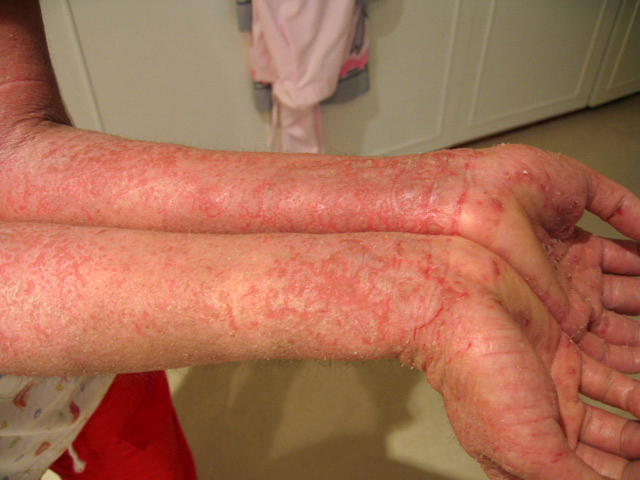 |
|
Regular monitoring of IOP and visual field examinations could be needed in glaucoma patients with severe atopic dermatitis. Photo: Jambula/Wikimedia Commons. Click image to enlarge. |
The chronic inflammatory skin disorder atopic dermatitis (the most common form of eczema) has been associated with various ophthalmic complications, including blepharitis, keratoconjunctivitis, keratoconus, glaucoma, cataracts and retinal detachment. Notably, glaucoma in patients with the condition has been reported to be associated with the use of topical and systemic steroids. The broader impact of atopic dermatitis on the clinical course of glaucoma remains understudied.
A recent study performed in Taiwan assessed the risk of requiring surgical intervention among glaucoma patients with and without atopic dermatitis. Their findings, which were published in Journal of Glaucoma, while also showing that the risk of surgery within the whole atopic dermatitis cohort remained comparable with patients without the condition, identified a significantly higher risk in glaucoma patients with its severe form. The team also hypothesized that the risk of developing glaucoma may be correlated with the severity of the condition and possibly be heightened in severe cases.
The retrospective cohort analysis included 528,469 glaucoma patients, of which 2,624 had atopic dermatitis. Among this group, 584 had the severe stage of the condition. The researchers identified those with severe atopic dermatitis based on their usage of prescribed drugs recommended in treatment guidelines. Patients receiving any prior therapy, which included one or more treatments of omalizumab, intravenous immunoglobulin, interferon-gamma or rituximab and/or treatment with cyclosporine, azathioprine, mycophenolate mofetil, methotrexate or systemic steroids for more than two weeks, were assigned to the severe atopic dermatitis group. Then, they compared the cohorts’ risk and cumulative incidence of needing glaucoma surgery (MIGS, trabeculectomy, aqueous shunt or transscleral cyclophotocoagulation).
The atopic dermatitis group showed a comparable risk of requiring surgery to the non-dermatitis group (hazard ratio [HR]: 1.03). In contrast, the severe dermatitis group demonstrated a significantly greater risk and cumulative incidence of surgery (HR: 2.80) compared to the non-dermatitis group. This elevated risk was significant as early as one year after glaucoma diagnosis (HR: 4.49), highlighting the role of severe atopic dermatitis in the early disease stage and its potential to accelerate glaucoma progression.
“The possible mechanism underlying our findings could be the intraocular inflammation caused by the condition,” the study authors wrote in their paper. “Such inflammation might cause damage and fiber buildup in the trabecular meshwork, leading to persistent elevation of IOP and progressive worsening of the visual field in glaucoma patients, ultimately necessitating surgical intervention.”
They noted that their findings highlighted the imperative for enhanced vigilance in the regular monitoring of IOP and visual field examinations in glaucoma patients with severe atopic dermatitis, and they recommended that such patients be referred to a glaucoma specialist at an early stage when deemed necessary.
“To achieve this, the formation of an interdisciplinary team is essential, encompassing expertise from dermatology, eye care, immunology and pediatrics to ensure a comprehensive approach to patient care,” the team suggested.
Chu YY, Lee CY, Huan WY, et al. Association of atopic dermatitis and risk of glaucoma surgery: a global population-based study. J Glaucoma. July 19, 2024. [Epub ahead of print]. |


